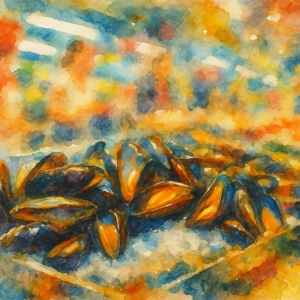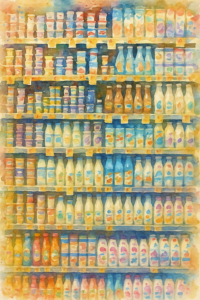“des fois”, “des fromages très forts”, and “des restes”. Do you know these phrases? Hear them in this clip of French in the wild. Set your level (A1 to DALF prep) and fill in the blanks of our transcription quiz. Updated daily with a FREE listening quiz!
Take the quiz, join the conversation.
Did you find this one challenging or easy? Did you hear something diffferent? What surprised you? What levels did you complete? Comment below and share what’s opening up for you with this quiz.
This clip is from Manger Episode 1. Listen and fill in what you hear below. Read more and find a translation below. Listen to the full episode here.
This audio sample and transcription is from Manger ep. 1. We do not own the content. Listen to the entire episode
sometimes
What’s opening up for you in this clip?
The snippet in English
Find a translation of this snippet here, how much of this did you hear?
Il y a des personnes d’ailleurs une fois qu’elle se libèrent de ça, qui mangent même des fromages très forts le matin, ça plaît pas toujours à toute la famille ou qui mangent même du poisson cru le matin, qui se font une espèce de ceviche de poisson, qui peuvent manger vraiment des choses très variées. Des fois même des restes du soir, je sais pas, un reste de ratatouille avec du pain, enfin.
Some people, once they’ve freed themselves from that, even eat very strong cheeses in the morning, which don’t always please the whole family, or even eat raw fish in the morning, make a kind of fish ceviche, and can really eat a wide variety of things. Sometimes even leftovers from the evening, I don’t know, leftover ratatouille with bread, or whatever.
The above translation from Deepl. Source
What does “des fromages très forts” mean?
When someone mentions liking to eat “des fromages très forts,” they are referring to cheeses that have a strong or pungent flavor. “Fromages très forts” translates to “very strong cheeses” in English. It indicates cheeses that possess intense flavors, often characterized by a pronounced aroma, robust taste, and distinctive characteristics.
Strong cheeses can vary in taste and texture depending on the type and aging process. They may have earthy, nutty, tangy, or even funky flavors.
- Roquefort: Roquefort is a well-known blue cheese made from sheep’s milk. It has a crumbly texture and is characterized by its distinct blue veins. It has a tangy, salty flavor and a strong aroma.
- Munster: Munster is a soft cheese made from cow’s milk. It has a washed rind and a creamy texture. It is known for its pungent aroma and robust flavor, which can be earthy and slightly spicy.
- Époisses: Époisses is a creamy cheese with a soft and runny texture. It is made from cow’s milk and has a washed rind. Époisses has a rich, savory taste and a strong, pungent aroma.
- Pont-l’Évêque: Pont-l’Évêque is a square-shaped cheese made from cow’s milk. It has a smooth, creamy texture and a distinctive washed rind. It has a strong flavor that can be described as nutty, earthy, and slightly tangy.
- Bleu d’Auvergne: Bleu d’Auvergne is a blue cheese produced in the Auvergne region of France. It has a crumbly texture and blue veins throughout. It has a robust and tangy flavor, with notes of mushroom and a slightly spicy finish.
Strong cheeses are often associated with a powerful aroma that can be assertive or pungent. The smell may be described as robust, musky, or even slightly piquant.
Strong cheeses can be enjoyed in various ways. They are often savored on their own or paired with complementary foods such as crusty bread, fruits, nuts, or honey. They are also used as ingredients in recipes to add depth of flavor to dishes.
Appreciation for strong cheeses is subjective and can vary among individuals and cultures. Some people enjoy the complex flavors and aromas, while others may find them overpowering. Strong cheeses are an important part of many culinary traditions and are valued for their distinct and bold characteristics.
It’s worth noting that personal taste preferences for cheese can vary widely. Some people enjoy the strong and robust flavors of these cheeses, while others may prefer milder or more subtle varieties. Exploring different types of cheeses allows individuals to discover their personal preferences and appreciate the wide range of flavors available in the world of cheese.
What does “des fois” mean?
The phrase “des fois” is a colloquial expression in French that can be translated to “sometimes” or “at times” in English. It is used to convey the idea of occasional or intermittent occurrences. “Des fois” is a contraction of the preposition “des” (some) and the noun “fois” (time). Together, it translates to “sometimes” or “at times.”
The expression “des fois” is commonly used in casual conversation to indicate that something happens on occasions but not necessarily consistently or regularly. It adds a sense of informality and spontaneity to the statement.
Examples:
- “Des fois, je vais au cinéma le week-end.” (Sometimes, I go to the cinema on weekends.)
- “Des fois, il oublie de prendre son parapluie.” (At times, he forgets to take his umbrella.)
- “Des fois, les trains sont en retard.” (Sometimes, trains are late.)
“Des fois” can be synonymous with other expressions like “parfois” (sometimes) or “de temps en temps” (from time to time). However, “des fois” is more colloquial and informal in nature.
What does “un reste” mean?
“Un reste” refers to leftovers or a leftover portion of food. It refers to the remaining portion of a meal or dish that has not been consumed and is intended to be eaten later. “Un reste” can be translated as “a leftover” or “some leftovers” in English.
When someone mentions eating “un reste,” they are referring to consuming the leftover food to avoid wasting it. It could be a single leftover dish or multiple items saved from different meals.
Examples:
- “Je vais manger un reste de pizza pour le dîner.” (I’m going to eat some leftover pizza for dinner.)
- “On peut se faire un repas avec les restes de hier soir.” (We can have a meal with the leftovers from last night.)
In many cultures, including French cuisine, it is common to save and consume leftovers rather than discarding them. It helps reduce food waste and is seen as a practical and sustainable approach to meal planning.
In France, it is not a common practice to take leftovers home from restaurants, especially in traditional or upscale establishments. Unlike some other countries where it is more customary, such as the United States, requesting a “doggy bag” or taking food to-go is not widely accepted in French dining culture.
There are a few reasons for this cultural difference. French cuisine places a strong emphasis on freshness, quality, and presentation. Meals are often prepared and served in portions intended to be consumed at the restaurant. Additionally, the French dining experience typically involves savoring each dish as part of a leisurely and communal event, rather than solely focusing on the consumption of food.
However, it’s worth noting that attitudes are evolving, and some modern and casual restaurants in France may be more accommodating when it comes to offering take-out options or packaging leftovers. It is always best to ask the restaurant directly if you are uncertain about their policy regarding leftovers.
“Des restes” typically refers to leftovers from home-cooked meals rather than restaurant meals in French. The term “des restes” indicates the remaining portions of food that have not been consumed and are intended to be eaten later at home. It is commonly used to describe the practice of saving and consuming leftover homemade dishes to reduce food waste.
In French, you may also hear variations like “les restes” (the leftovers) or “les restants” (the remains) to refer to the same concept.
What did you love about this?
Comment below with your feedback! Tells us what you think. Send a note or leave a comment below. We appreciate the feedback. Also, we’re always looking for partners to build this site and grow the content available.
“des fois”, “des fromages très forts”, and “des restes”. Do you know these phrases? Hear them in this clip of French in the wild. Set your level (A1 to DALF prep) and fill in the blanks of our transcription quiz. Updated daily with a FREE listening quiz!
Take the quiz, join the conversation.
Did you find this one challenging or easy? Did you hear something diffferent? What surprised you? What levels did you complete? Comment below and share what’s opening up for you with this quiz.








